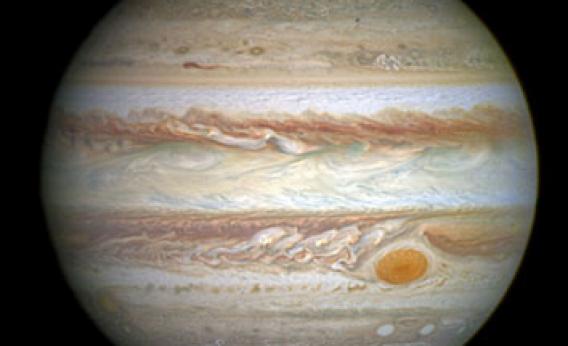Create a free profile to get unlimited access to exclusive videos, sweepstakes, and more!
Jupiter’s Great Red Spot Is Shrinking

“It’s shrinking! It’s shrinking!”
— Walter Curnow
Well, this is weird: Jupiter’s enormous Red Spot is shrinking.
And it’s not being too subtle about it. In the late 1970s it was over 23,000 kilometers (14,500 miles) across. A recent Hubble observation shows it’s now down to a mere 16,500 kilometers (10,250 miles) in diameter.
In human terms: Just the amount of diameter it’s lost is comfortably wider than continental United States. In area, that’s roughly 25 million square kilometers (10 million square miles), 2.5 times the area of the entire U.S. It appears to be shrinking at the stunning rate of more than 900 kilometers (580 miles) per year.
Yikes.
The Red Spot is a giant, stable, circulating storm, a huge vortex still big enough to easily swallow the Earth without our planet even touching the sides. But then, if the Spot keeps shrinking, in a few years that will no longer be true.
Chalk one up to shrinkage.
The Spot has been visible for centuries, a red oval easily seen even in small telescopes. Apparently, estimates of its size dating back to the late 19th century gauge it at 41,000 kilometers (25,500 miles) long, so it’s been losing girth for quite some time. Not only that, but recent observations have shown it’s getting more circular with time as well.
So what gives? It’s hard to say. Jupiter is a dynamic place, and we only really see the top of its ridiculously deep cloud layer. But even then it’s banded, festooned, and dotted with dozens of planet-sized storms that come and go all the time. Heck in 2010, one of its broad brown belts disappeared from view for several months! Apparently it sank a bit, and bright white ammonia clouds formed above it, hiding it from view (it eventually came back). That happened back in the 1990s, too, when I was a grad student, and it was freaky to see the giant planet with only one belt. It looked lopsided.
Looking at pictures taken over the course of a few years, it doesn’t look to me that the Spot is being covered by other clouds; it looks physically smaller. The change in shape would support that as well. One thing that’s been seen is that smaller storms can be consumed by the Spot, basically absorbed by it. That changes the internal dynamics of the Spot, and may have something to do with this behavior.
However, we don’t really know. While I have a hard time thinking the Spot will simply evaporate away into nothing (the internal energies we’re talking about here are vast—a typical thunderstorm on Earth has as much energy as a nuclear bomb, and the Red Spot is a storm the size of a freaking planet), we absolutely should be keeping our eyes on it and study it further. It’s a little weird to think that we don’t really have much of a clue on what forces are shaping one of the single largest planetary features in the solar system.
I’m actually wondering what we’d see if we could look into the Spot with extremely high resolution …
I’d hate to think this is because NASA is finally taking a Europa probe seriously.


























